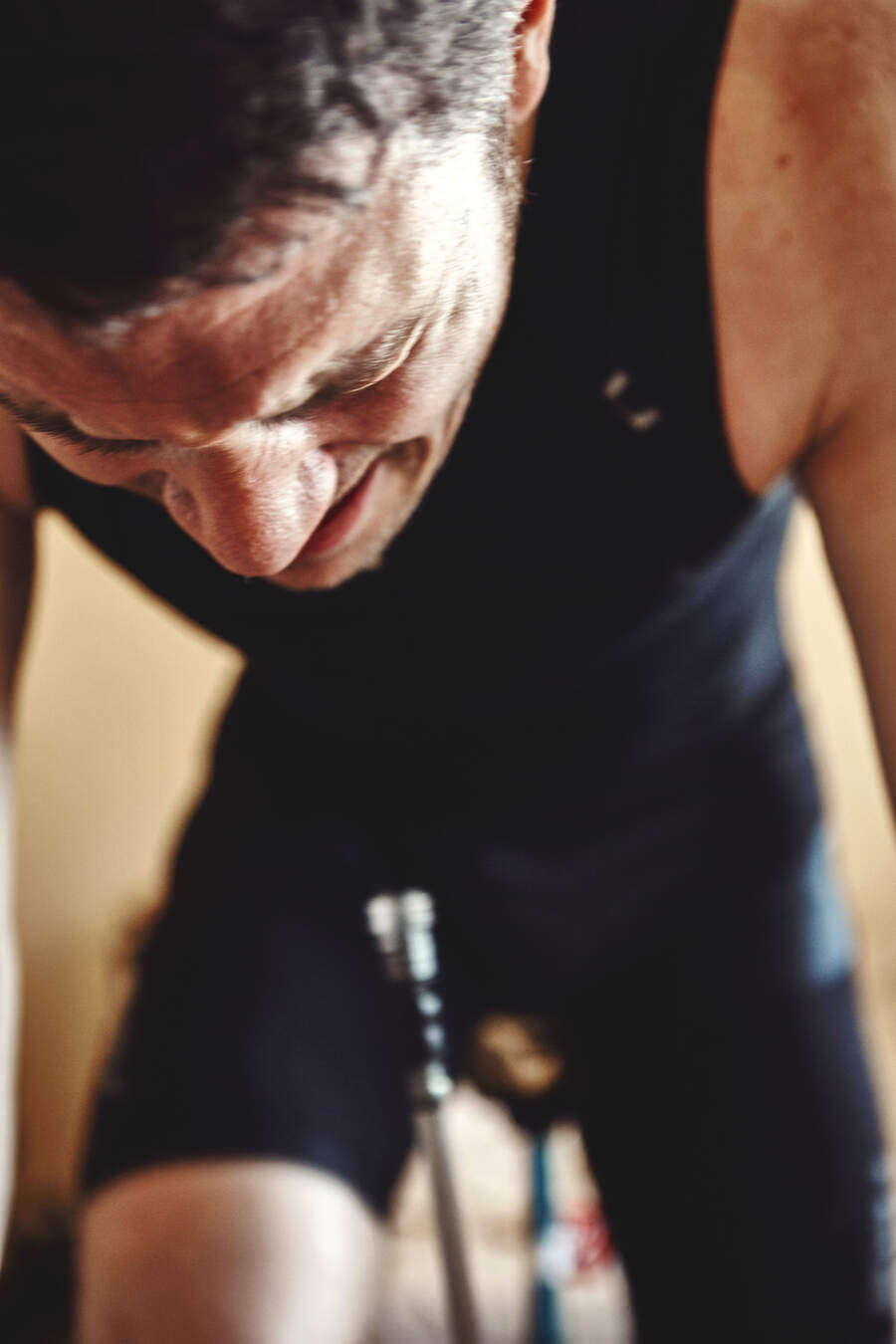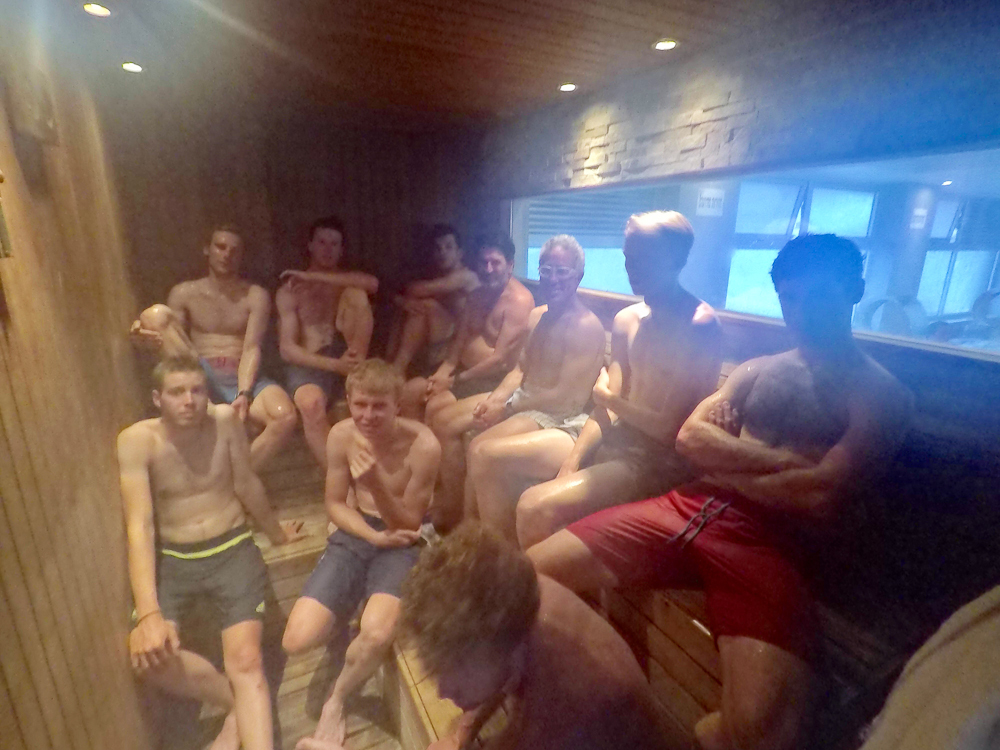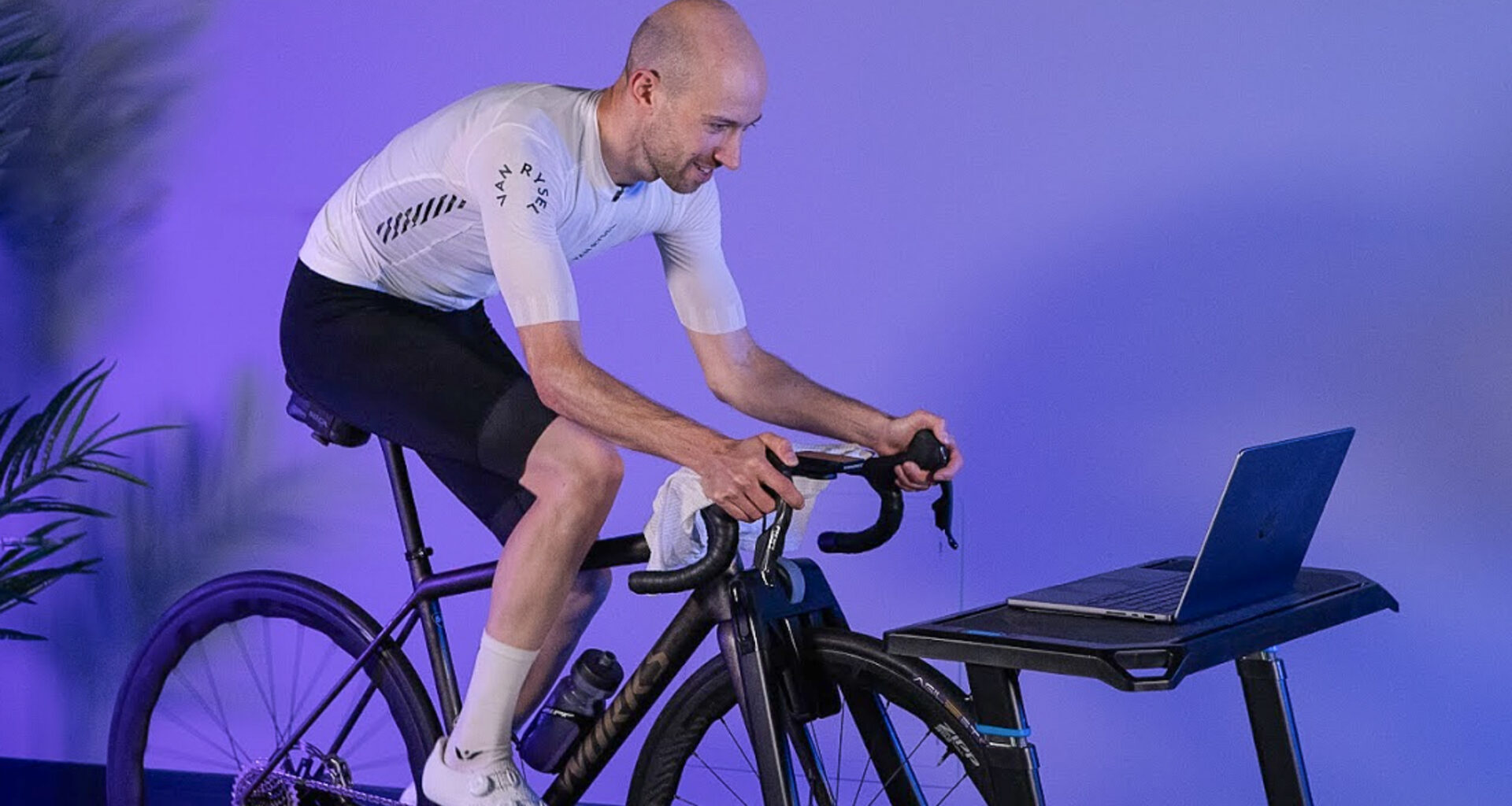For many cyclists, indoor training during the warmer months can feel like an unnecessary hardship. The sweat pours, heart rate climbs disproportionately to power output, and motivation often wanes. However, this discomfort can become one of the most powerful, performance-enhancing tools at your disposal.
When used deliberately and carefully, training in the heat – particularly indoors with specific protocols – can unlock a range of physiological adaptations that not only prepare you for hot-weather racing but also improve performance across all conditions. ‘Train hot – race cool’ is the latest in-vogue training phrase in cycling.
This is significant, as cyclists are not particularly efficient. At best, a top-level World Tour rider will have an efficiency of around 25%, whereas most other riders are around 20%. When a rider produces 300 W of power, this generates 1080KJ of energy to power the pedals, as one watt equals 3.6KJ/hr. With a 25% efficiency, that means 4320KJ is being burned, of which 3240KJ is turned to heat.
You may like
This takes a lot of energy to remove from the body and, when the body temperature level heats up too much, the body starts to prevent itself from generating more. In other words, you can’t sustain power and you have to slow down. If you improve your capacity to lose heat, you can push more watts for longer before thermal load becomes too much.
The ability to attain these benefits is not limited to elite-level athletes. Thanks to tech innovations and structured training methodologies, heat acclimation training is now accessible to anyone with a smart trainer, a Core sensor or other thermometer method, and a basic understanding of physiology. This article explores the science behind heat training, how to use it to your advantage, what to be cautious of and how hydration, fuelling and recovery strategies must be adapted to support this unique form of stress.
How the body adapts to heat
When the body is exposed to repeated heat stress, it undergoes several key adaptations. Within a span of around seven to fourteen days (assuming consistent exposure), cyclists can experience significant improvements in their ability to tolerate thermal strain. This is known as heat acclimation. One of the primary adaptations is an increase in plasma volume. This enhances cardiovascular stability and improves oxygen delivery to working muscles, enabling sustained efforts at lower heart rates.
The body also becomes more efficient at cooling itself. It begins sweating earlier and more profusely, which helps dissipate heat more effectively via the convection process of evaporating sweat, removing body heat. Over time, these changes result in a lower core temperature at any given workload, a reduction in perceived exertion, and enhanced efficiency.
The latest race content, interviews, features, reviews and expert buying guides, direct to your inbox!
Cellular changes also occur. Heat shock proteins are upregulated in response to thermal stress, improving muscular resilience and recovery. In a well-cited study by Santiago Lorenzo et al., in 2010, trained cyclists who undertook ten days of heat acclimation improved their time trial performance by as much as eight per cent, compared to the control group, even when competing in cooler conditions. The improvements were attributed to an increase in blood volume and a more effective thermoregulatory system, allowing the athletes to sustain higher power outputs with less physiological strain.

(Image credit: Alamy)Why heat training helps performance in all conditions
The physiological strain imposed by heat acts similarly to training at altitude. The cardiovascular system works harder at the same relative workload, placing a greater demand on the heart, lungs, and thermoregulation systems. This results in greater training adaptations over time in response to this different stress source. Crucially, these adaptations are not confined to hot-weather events. Riders who prepare using heat training often experience better performance across the board, particularly in longer events where cardiac drift and rising core temperatures can otherwise impair pacing and endurance.
Training indoors for heat adaptation
One of the most effective ways to create a heat adaptation stimulus is through indoor training, using any of the best smart trainers, and indoor cycling apps such as MyWhoosh.
The indoor environment naturally limits airflow and creates a pocket of warm, humid air around the rider. This amplifies thermal strain, particularly if the fan is used sparingly or an extra layer of clothing is worn. Even moderate-intensity sessions can raise core temperature significantly in this context.
Riders can further enhance the precision of this approach by using some form of dedicated thermometer. In-ear measurements are fairly non-invasive, or a CORE Body Temperature sensor provides real-time monitoring of internal temperature.
This allows training load to be adjusted based on thermal stress rather than just power or heart rate. Targeting a core temperature between 38.5 and 39.5˚C during these sessions appears to provide the optimal balance between stimulus and safety. It should be noted that exceeding that temperature level can cause excessive thermal strain and impair recovery significantly.
Using heat suits for controlled adaptation
Newer tools, such as dedicated heat suits, which look very similar to a painter’s coveralls, have also emerged as part of this approach.
A heat suit uses controlled insulation to elevate core temperature gradually and predictably, making it easier to standardise heat exposure without relying entirely on ambient conditions. You can achieve a higher core body temperature more quickly on the turbo in the summer than the winter due to atmospheric conditions, but the suit standardises that somewhat.
This can be particularly useful for riders in cooler climates or those seeking a consistent training environment in the build-up to an event. But be prepared to have a puddle of sweat pooling at the base of the suit – towels on the floor for after these sessions is a must.

Heat training isn’t a new fad. Here, Cycling Adacemy riders are seen crammed into a sauna together in 2016. (Image credit: Courtesy of Cycling Academy)Passive heat training and hot water immersion
For riders who find it difficult to perform structured sessions in hot conditions, or those looking for a low-stress way to add thermal load, passive heat adaptation methods offer a viable alternative. One of the most studied and effective techniques is post-exercise hot water immersion. This involves sitting in a bath at approximately 40˚C for 30 to 40 minutes immediately after training. The rise in core temperature extends the thermal stress window and drives similar adaptations to those achieved during active heat training. Research by Michael Zurawlew et al., in 2015 demonstrated that this method can be highly effective, even when ambient temperatures are relatively cool. Passive heat strategies are especially useful during taper weeks or for athletes who are unable to tolerate prolonged heat exposure due to illness, fatigue, or injury.
Hydration and electrolyte replacement in the heat
While heat training offers powerful benefits, it also increases the physiological demands placed on the body. One area that requires particular attention is hydration. In hot conditions, sweat rates can easily exceed 1.5 to 2 litres per hour. If fluid losses are not replaced, performance and rider safety are both compromised. A loss of just two per cent of body weight through dehydration can impair endurance, raise perceived exertion, and interfere with the body’s ability to regulate its internal temperature. However, those figures are based on untrained populations, and in fact, one of the heat training adaptations for performance is reduced impairment due to dehydration. Many professional athletes function well despite fluid loss greater than 2%. However, in Tour de France stages, riders can also consume around 5 litres of fluid over a 5-hour stage.
To monitor sweat loss, cyclists should weigh themselves before and after sessions, while not wearing any kit, to monitor fluid loss and should aim to replace 150% of that loss after training. This becomes even more important during heat blocks or multi-day training cycles.
Electrolytes are also crucial. Sweat contains not only water but also significant amounts of sodium, along with smaller quantities of potassium, magnesium and calcium. Over time, these losses can lead to cramps, fatigue, and impaired neuromuscular function. Sodium loss varies widely between individuals but is typically in the range of 500 to 1,000 milligrams per litre of sweat. Riders undertaking frequent or prolonged heat sessions should consider using a drink mix that contains adequate electrolytes. Products such as those from Precision Hydration or Maurten are formulated specifically for this purpose.

(Image credit: Sam Gupta)Increased carbohydrate needs with heat exposure
Carbohydrate requirements also rise when training in the heat. This is partly because the body relies more heavily on carbohydrate oxidation at higher core temperatures, and partly due to the elevated overall stress. For the same relative intensity, riders may need 10 to 20% more carbohydrates to maintain performance and avoid excessive glycogen depletion. As a result, fuelling strategies should be adapted accordingly. For sessions lasting more than 90 minutes, aim for 60 to 90 grams of carbohydrate per hour, using a combination of glucose and fructose to maximise absorption if above 60g/hr. Recovery nutrition should also be prioritised, with particular attention being paid to replenishing glycogen stores and replacing lost fluids and electrolytes.
How to structure heat adaptation into your training plan
Integrating heat training into your plan does not require a complete overhaul. In most cases, three to five sessions per week, lasting between 45 and 60 minutes, is sufficient to generate adaptation. These sessions can be performed indoors without fans, wearing an extra layer, or with the help of a heat suit.
Some even find that simply switching off the fan at the end of an indoor interval session or race to perform 20 minutes and maintain an elevated core temperature. You could even join the Cyclingnews Autobus Ride on MyWhoosh and trial toggling the fan off towards the end to see how you feel.
Passive heat strategies, such as hot water immersion, can be used on alternate days or as a supplement to active training. It is common to perform a heat training block of around ten days in the lead-up to a target event, ideally finishing the block two to three weeks before race day to allow for full recovery and consolidation of adaptations.
Cautions and individual considerations
However, caution is warranted. Heat training adds another layer of stress to an already demanding training load. It is essential to monitor for signs of non-functional overreaching or early burnout. These may include an elevated resting heart rate, poor sleep, low mood, declining power outputs, or an inability to recover between sessions. Female athletes may also need to consider the influence of the menstrual cycle on thermoregulation. During the luteal phase, higher baseline body temperature and reduced heat tolerance may necessitate reduced intensity or additional recovery between sessions.
Given that training is all about balancing the overall stress load, for people who are working full-time jobs, have children, or are in education, it’s probably best to avoid adding heat training to your routine. Unless undertaking specific events where heat acclimation will make a difference, such as an event in high temperatures. Adding an additional stressor might be better served by incorporating appropriate high-intensity training or maximising volume. Train for the demands of your specific event or goal, and work backwards from the end target.
As with all training interventions, heat adaptation should be individualised. Start with short, low-intensity sessions and gradually build exposure as tolerance improves. Use metrics such as perceived exertion, heart rate, and temperature feedback to gauge internal load, and be prepared to back off if fatigue begins to accumulate.
Conclusion
In summary, training in hot conditions – whether indoors, outdoors, or passively through hot water immersion – offers a potent stimulus for performance gains. The physiological adaptations include improved cardiovascular function, enhanced thermoregulation, and more efficient energy use. When combined with appropriate hydration, salt intake, and carbohydrate fuelling, heat training can form a valuable part of any rider’s preparation for competition. With specialist tools like the CORE Body Temperature sensor and heat suits, applying this training method to the same degree as the pros is even more practical and achievable.
Used wisely and with respect for the body’s limits, heat adaptation can help riders build resilience, increase blood volume, improve endurance, and achieve peak performance in all weather conditions. It’s even been described by some World Tour trainers as a sort of Altitude-Lite training, but with significantly less financial investment required.
Cyclingnews created this content as part of a paid partnership with Cyclingnews. The contents of this article are entirely independent and solely reflect the editorial opinion of Cyclingnews.

